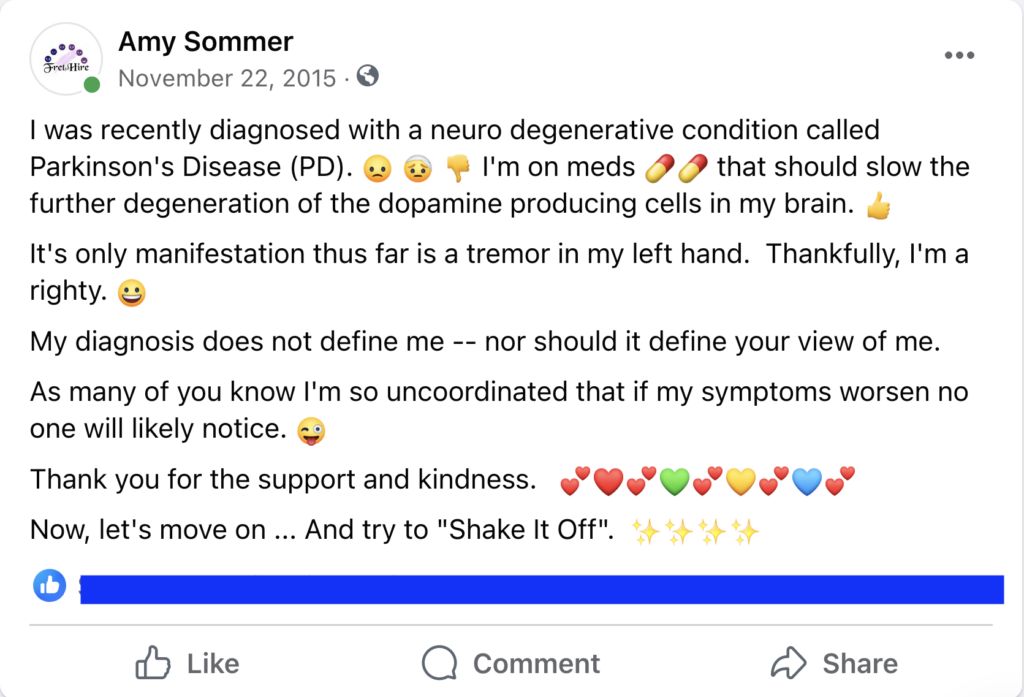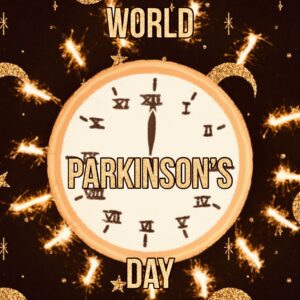All, Parkinson's Disease
Parkinson’s Awareness Month Reflections

April 2024 was Parkinson’s Awareness Month. I’m aware I have PD, as are many of you. We’re in the know, lucky us.
So, let’s hunker down and find a cure. Please.
Dr. James Parkinson, who first identified the disease in an 1817 essay, “An Essay on the Shaking Palsy,” was born on April 11, 1755, and died on December 21, 1824. In 1997, the European Parkinson’s Disease Association (EPDA) and the World Health Organization (WHO) created a holiday on his birthday, and so for the past 27 years, we’ve “celebrated” World Parkinson’s Day.

Were that this holiday was a truly magical celebration. It’s one of my Parkie fantasies (no, I haven’t mixed up my meds, nor am I imbibing) that the declaration of this holiday would transform the space-time continuum such that on each of the 27 World Parkinson’s Days thus far (and for the few more that might be needed going forward) time for people with Parkinson’s and PD researchers would be warped so that April 11 of each year would be the equivalent of two research years, in the same way we measure dog years against their human counterparts. But in a good way. Like the opposite of fate’s cruel timekeeper that forces dog lovers to mourn our pets’ passings too soon and too often. Maybe then the much-hyped promise of a cure being “just around the corner” could be realized in time to freeze my disease’s forward progress instead of my gait or facial expressions. Like many, I fantasize about bending time to my will.
I want to buy time—time for brilliant minds to ponder paradigms, discover drugs, and formulate fixes by which my dopaminergic brain cells would stop offing themselves. Time to derail this disease’s [or diseases’. There is a growing body of research that suggests PD might be a few diseases under the one idiosyncratic PD umbrella. The way that Cancer is a catchall for a multitude of viruses] progress. Time, time I may never have.

Time marches on. And so does my disease. I am getting worse. Parkinson’s disease … sucks more each day. They don’t call Parkinson’s progressive because it leans left.
When I am “off” (in the PD sense of when my medication is not in full effect), the disease rattles my world – I type with one hand, use a cane, and move as if enveloped in molasses. My view of myself as a maternal rock crumbles in the face of dopamine’s abandonment: my daughter ties my shoelaces; my son pulls me from sitting to standing. “Flow” is limited to three hours (at least until my insurance carrier acknowledges my need for the longer-acting formula of my medication. And no, not the generic one that neurologists everywhere scoff at, the branded one, the formulation that is actually released over time. More on this in another post.) I am The Giving Tree, forced to receive, humbled to the point of helplessness, too shaky to access fine motor skills. “Honey, could you please get me two pills from the bottle?”
It’s unfair. It sucks. But it is what it is.
We plan. God laughs. If you’d told me that I’d be diagnosed with Parkinson’s disease at 50, I would’ve laughed at the notion’s absurdity. But for reasons that I, like many others, wish science would figure out, NOW, something in my body has come home to the roost, having squandered so many of these precious brain cells even before symptoms present themselves.
Second only to Alzheimer’s, current estimates put the number of people in the USA living with Parkinson’s at about a million, with some 90,000 new cases diagnosed annually (although a recent study strongly suggests that these estimates are low).
Two months after showing my tremorous left hand to my then General Practitioner, I sit across from a neurologist while holding a coffee from one of the multitude of “back to school” gatherings. She administers a series of tests that resemble those law enforcement gives to suspected drunk drivers.
The neurologist tells me (in a kinder tone than brevity demands) that I have one of three maladies: multiple sclerosis (MS), a brain tumor, or Parkinson’s disease (no, the “d” isn’t capitalized – everything about this disease is bothersome). An MRI is required to see if there are ‘plaques’ on my brain (which would mean MS), or a mass that doesn’t belong (brain tumor). If neither of those is evident, it’s the nightmare behind Door Number 3.
Ten days later, my head and neck are secured with a brace, and I am fed into an MRI . A few days later there’s a voicemail from the general neurologist telling me that my brain looked great… and that I should make an appointment with the Movement Disorder Clinic.
I don’t bother calling her back. I take the first available new patient appointment and vow to avoid medical websites for the next three months.

“How long has that been going on?” One of my besties, a neurologist, asks, her eyes suddenly saucer wide.
“For a couple of months,” I respond matter-of-factly. “The MRI was clean. I have an appointment with one of your colleagues in January.”
She calls in favors. Miraculously, two months morph into two weeks. On Thursday, November 5, 2015, a preeminent movement disorder specialist confirmed what I already knew. It’s been 134 days since my 50th birthday. It’s the first day of my next chapter.
Nine years later, I remain ignorant of but grateful for the chips my pal cashed to get me in that leading specialist’s chair.
I must learn to accept my cells’ suicidal betrayal and their feckless disregard for their rightful place in my neurological family. It doesn’t matter why they’ve abandoned their posts within the substantia nigra. It is what it is – and I am what I am as a result; denial doesn’t alter my dopaminergic reality. Pity.
Getting to okay is an arduous process, one that requires emotional heavy lifting, a process that resembles Elisabeth Kübler-Ross’ Model of Grief – denial, anger, bargaining, depression, and acceptance – to arrive at what Kubler-Ross calls acceptance the state of being where you mean it when you say, “it is what it is, and I am what I am.” And it’s okay.
I am a Person with Parkinson’s disease. A Parkie. Someone who resembles a human immersion blender when my dopamine replacement wears off. I am Gene Wilder’s character in “Blazing Saddles” who utters, “yes, but I shoot with this hand” when holding out his trembling southpaw. I am shaken. Not stirred.
But I am not without hope. I fight the good fight daily – eat well (yeah, sometimes too much of a good thing makes one… well, fat, but I’m working on that too) I exercise. I volunteer to be a human guinea pig. I donate many charitable dollars to PD research. Sometimes I pray.
I want more. More dopamine-producing cells. More “on time”. More time to parent my children before they must care for me. More time as a partner versus a patient. More time. Like many, I want more time.


My partner was diagnosed with Parkinson’s disease at the age of 66.. His symptoms included excruciating calf pain, muscular aches, tremors, slurred speech, frequent falls, loss of balance, and trouble standing up from a seated posture. After six months on Senemet, Siferol was given to him in place of the Senemet. It was also at this period that he was diagnosed with dementia. He began seeing hallucinations and became detached from reality. With the doctor’s approval, we stopped giving him Siferol and chose to try the Natural Herbs Center PD-5 protocol, which we had already looked into. After three months of therapy, he has made significant progress. The illness has been completely contained. There are no symptoms of persistent twitching, weakness, tremors, hallucinations, or muscle soreness. The PD-5 Protocol was obtained from natural herbs centre. com. Though you still need to determine what works best for you, I thought I would share my husband’ s story in case it could be helpful. Greetings and prayers
FWIW, you’re one of the strongest people I know — strongest of character, that is (I don’t mean Incredible Hulk-type strength!). I learned that about you about 40 years ago, and it is part of what makes me love you as one of my dearest, most reliable, steadiest (and forgiving) friends. I can’t imagine what it’s like being in your shoes — it’s hard enough being in my own shoes when my feet hurt. But what I do know is that if *anyone* can navigate this sea of annoyance, awfulness and, I imagine, at times horror, it’s you. You have the support of phenomenal family and wonderful friends (completely above and beyond my own poor efforts). This isn’t an end; it’s a journey, and we’re all on it with you, loving you, and bathing in your love of us. See you soon, my Dear Friend
My husband was diagnosed of Parkinson’s Disease a couple of years ago, he had severe fatigue, difficulty with mobility and sleeping. He was placed on Sinemet 3 times daily, which helped but only for a short while. So, we decided to try alternative treatment and began on PD-5 protocol, it has made tremendous difference for my husband, he had improved walking balance, muscle strength and he is now very active. His Parkinson’s is totally under control, we got the treatment from binehealthcenter. com. This treatment is a breakthrough for PWP!
My wife was diagnosed of Parkinson’s Disease at age 61. She had severe calf pain, muscle pain, tremors, slurred speech, frequent falls, loss of balance, difficulty in getting up from sitting position. She was put on Senemet for 6 months and then Siferol was introduced and replaced the Senemet. During this time span she was also diagnosed with dementia. She started having hallucinations and lost touch with reality. Last year, our family doctor started her on Uine Health Centre PD-5 formula, 2 months into treatment she improved dramatically. At the end of the full treatment course, the disease is totally under control. No case of dementia, hallucination, weakness, muscle pain or tremors. My wife is strong again and has gone on with her daily activities as I share this experience. I’m surprised a lot of PWP haven’t heard of PD-5 formula. we got the treatment from their website uinehealth centre . c om
My husband was diagnosed of Parkinson’s Disease a couple of years ago, he had severe fatigue, difficulty with mobility and sleeping. He was placed on Sinemet 3 times daily, which helped but only for a short while. So we decided to try alternative treatment and began on PD-5 protocol, It has made tremendous difference for my husband, he had improved walking balance, muscle strength and he is now very active. His Parkinson’s is totally under control, we got the treatment from uineheathcentre. com. This treatment is a breakthrough for PWP!
In 2019, I began experiencing symptoms of Parkinson’s disease, which was diagnosed in 2021. Among my severe symptoms were tremors, difficulty walking, weakness throughout my body, and stiffness and rigidity. My meds only provided temporary relief, so I decided to try other approaches and started the PD-5 treatment program from uinehealthcentre . ne t. With the help of this therapy regimen, I have seen significant improvements in my walking, balance, tremors, and appetite, and I have resumed my guitar playing again and sign my name as I had before Parkinson’s. I am incredibly grateful.